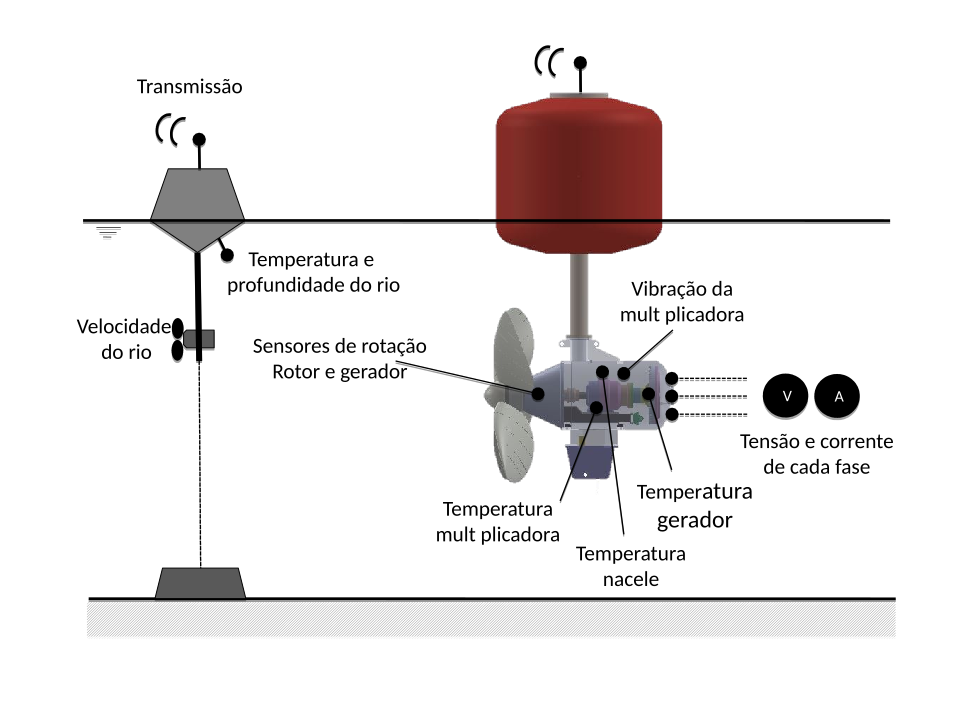Monitoring a hydrokinetic converter system for remaining energy in hydropower plants
Keywords:
Hydrokinetic turbines, Wireless Sensor Networks, Internet of Things (IoT), Instrumentation, system monitoring, graphical user interfaceAbstract
The aim of the present paper is to discuss the monitoring strategies for a modular hydrokinetic turbine system. A floating triangular-frame arrangement of three propeller hydrokinetic turbines is installed in the outflow channel of a hydropower plant, in the interest of remaining water stream energy conversion. The monitoring techniques based on Wireless Sensor Networks (WSN) and the Internet of Things (IoT) are reported, taking into account the specific framework of the instrumentation and data management in field experiments.
Downloads
References
N. D. Laws and B. P. Epps, “Hydrokinetic energy conversion: Technology, research, and outlook,” Renewable and Sustainable Energy Reviews, vol. 57, pp. 1245–1259, 2016.
M. I. Yuce and A. Muratoglu, “Hydrokinetic energy conversion systems: A technology status review,” Renewable and Sustainable Energy Reviews, vol. 43, pp. 72–82, 2015.
A. K. Sleiti, “Tidal power technology review with potential applications in Gulf Stream,” Renewable and Sustainable Energy Reviews, vol. 69, pp. 435–441, 2017.
M. Anyi and B. Kirke, “Evaluation of small axial flow hydrokinetic turbines for remote communities,” Energy for Sustainable Development, vol. 14, no. 2, pp. 110–116, 2010.
H. J. Vermaak, K. Kusakana, and S. P. Koko, “Status of microhydrokinetic river technology in rural applications: A review of literature,” Renewable and Sustainable Energy Reviews, vol. 29, pp. 625–633, 2014.
M. J. Khan, G. Bhuyan, M. T. Iqbal, and J. E. Quaicoe, “Hydrokinetic energy conversion systems and assessment of horizontal and vertical axis turbines for river and tidal applications: A technology status review,” Applied Energy, vol. 86, no. 10, pp. 1823–1835, 2009.
Y. Liu and D. J. Packey, “Combined-cycle hydropower systems - The potential of applying hydrokinetic turbines in the tailwaters of existing conventional hydropower stations,” Renewable Energy, vol. 66, pp. 228–231, 2014.
E. Lalander and M. Leijon, “In-stream energy converters in a river - Effects on upstream hydropower station,” Renewable Energy, vol. 36, no. 1, pp. 399–404, 2011.
P. d. S. Holanda, C. J. C. Blanco, A. L. A. Mesquita, A. C. P. Brasil Junior, N. M. de Figueiredo, E. N. Macˆedo, and Y. Secretan, “Assessment of hydrokinetic energy resources downstream of hydropower plants,” Renewable Energy, vol. 101, pp. 1203–1214, 2017.
A. C. Brasil Junior, R. C. F. Mendes, T. F. Oliveira, T. Andriamparany, M. Kouidri, and A. L. Mesquita, “On the hydrodynamics of a row arrangement of hydrokinetic propeller turbines,” American Journal of Hydropower, Water and Environment Sytems, vol. 3, pp. 19–24, 2016.
A. C. Brasil Junior, R. C. Mendes, T. Wirrig, R. Noguera, and T. F. Oliveira, “On the design of propeller hydrokinetic turbines: the effect of the number of blades,” Journal of the Brazilian Society of Mechanical Sciences and Engineering, vol. 41, no. 6, 2019.
I. Montero Dupont, R. I. Soares Pereira, S. C. Silveira Juca, and P. C. Marques de Carvalho, “Internet of Things Data Acquisition System Applied to Photovoltaic Water Pumping,” IEEE Latin America Transactions, vol. 16, no. 10, pp. 2547–2560, 2019.
C. Albaladejo, P. S´anchez, A. Iborra, F. Soto, J. A. L´opez, and R. Torres, “Wireless sensor networks for oceanographic monitoring: A systematic review,” Sensors, vol. 10, no. 7, pp. 6948–6968, 2010.
G. Durante, W. Beccaro, and H. E. M. Peres, “IoT Protocols Comparison for Wireless Sensors Network Applied to Marine Environment Acoustic Monitoring,” IEEE Latin America Transactions, 2019.


